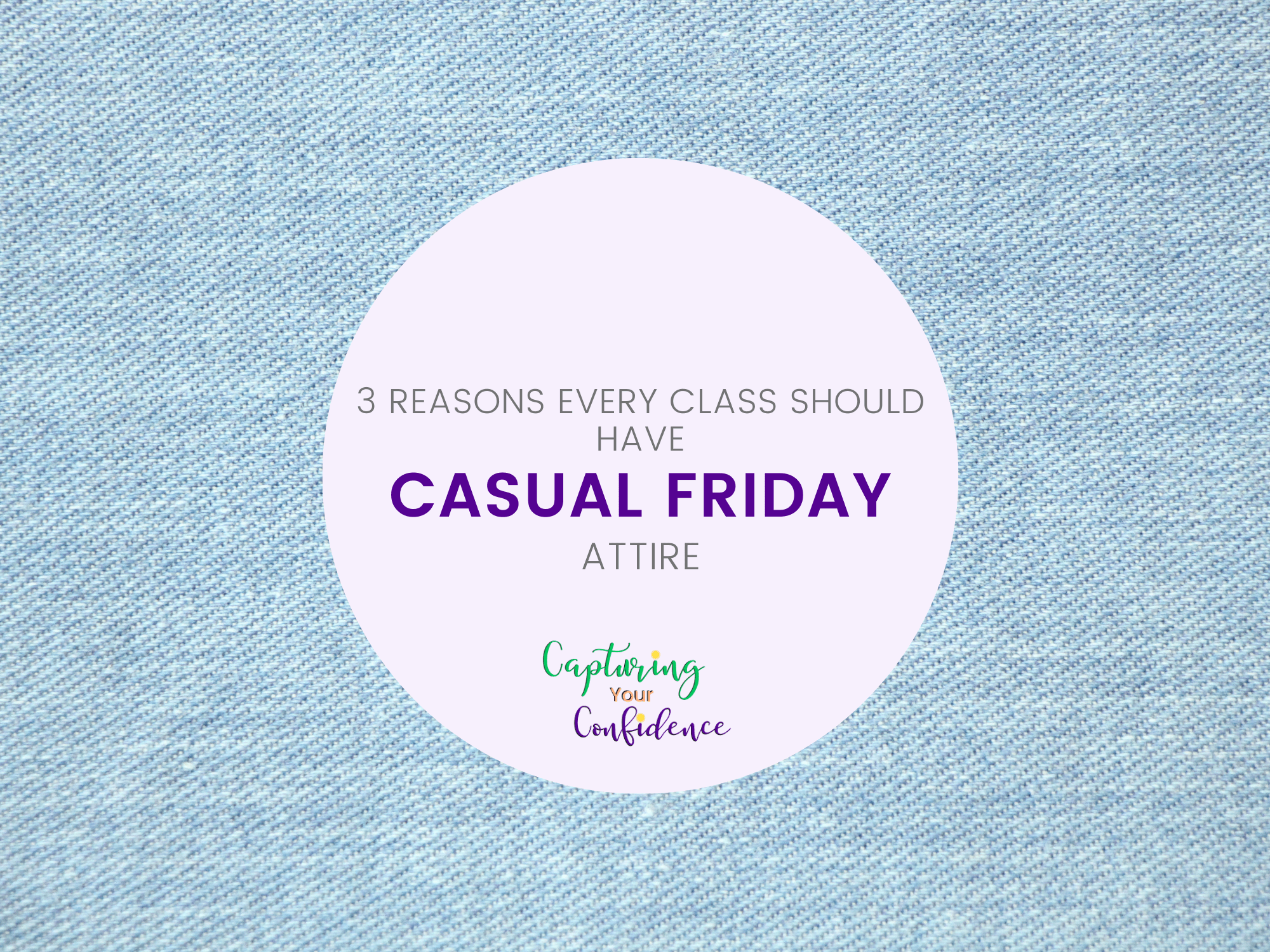3 Reasons Every Class Should be Casual Friday Attire
After the semester is in full swing, I begin converting my attire to casual. Usually, jeans and a nice dress shirt.
My very first semester teaching, I was scared to death to stop “dressing up” for class. I wore a dress shirt, slacks, and dress shoes with pantyhose. I took the extra time to do my makeup and hair nicely. It was really as if I was interviewing 3 times a week - at least that’s what I thought.
I eventually did convert over, at the very end of the semester, when I was so tired it took effort to put a matching outfit together at all. What I found was shocking.
Not only did the students not care what I was wearing, but I engaged with them better.
Not only did the students not care what I was wearing, but I engaged with them better. I was more comfortable in my own skin and prepared to do more creative activities and discussion in class because - shock of the day - I actually felt like myself instead of just a role I was playing.
Being a college English teacher is a lot of responsibility, and at 22 when I started teaching, I had much more strict notions of what I thought I should be like in that role. I thought I needed to dress up to garner respect from the students and be known as the authority in the classroom.
As it turns out, my authority in the classroom doesn’t come from what I’m wearing, it comes from my experience and what I know. This revelation was a surprise, but probably shouldn’t have been. Why did I assume that wearing nice clothes would earn me respect and authority in the classroom more so than casual clothing? Why did it matter at all?
The main conclusion I’ve come to is that I hadn’t seen many relaxed teachers before I started teaching my own classes. Much of my formal education involved teachers in dress attire with formal “strict” procedures we had to follow. I was lectured at a lot, and while my teachers were certainly knowledgeable experts, many of them didn’t engage with classes like I do.
In fact, the most memorable teachers I’ve had were those who engaged more and seemed less focused on the formalities of the classroom. They were receptive to student knowledge and worked hard to engage students where they were at rather than assuming knowledge levels and then lecturing for 50 minutes three times a week.
This isn’t to say that any college English teachers I encountered were unprofessional. On the contrary, I find the diversity in the displays of professionalism intriguing, and even inspiring. Some of the most distinct lines between these differences are generational, geographical, and cultural.
I find the diversity in the displays of professionalism intriguing, and even inspiring.
Probably the biggest difference I’ve seen is between male and female professors. In my experience, it seems the ladies tend to take more care with their outfits and general appearance. The gentleman are much more likely to come to class wearing casual attire like jeans.
It begs the question - does the attire really matter? If female professors dress up for class and male professors don’t, does that change the content or delivery of the material? I don’t think so.
Personally, I dress “nicely” for the first weekor two; but, the rest of the semester is much more casual! And, as I gain more teaching confidence, I start bringing in my casual attire sooner.
Here’s why:
Comfortable Attire = Comfortable Presentation of Material
When I’m dressed comfortably, which for me means casually, I am more confident. I don’t have to worry about my nice clothes being itchy or constrictive. Or my dress shoes leaving blisters.
I am free to share knowledge, answer questions, and make students interact with each other so they can learn together. I am more creative in my presentation of material, and because I’m more comfortable, class just goes...well, better.
I am more creative in my presentation of material, and because I’m more comfortable, class just goes...well, better.
This isn’t to say that no one is comfortable in more formal attire; however, the main question to ask yourself when considering whether or not to dress formally is what goal you are achieving by doing so.
Are you dressing formally to prove a point? Or to present a specific level of credibility? Because you are unsure if you are allowed to be more casual?
Whatever answer you come to, it’s important to remember that the more comfortable you are in your own skin, the better and more effective you can be as a college English teacher.
Self-Awareness of Teacher Ethos
In first year composition (FYC) we teach students about the rhetorical triangle. If you are unfamiliar with this terminology, there are three main concepts:
Ethos - Credibility; How does the author present themselves & the material? Why do we believe the author, or why not?
Pathos - Emotion; How does the author attempt to sway your emotions and tug at your heartstrings in attempt to persuade you?
Logos - Logic; How does the author appeal to your logic? What evidence do they use to support their claims?
We learn about how writers use these methods of persuasion to effect audiences, and then students analyze imagery and text to see how they work. Many times, we teachers use familiar examples, like ourselves, to explain each appeal.
How we present ourselves in the classroom can determine the course of the semester, especially that first week when students don’t really know the instructors yet.
While this is a standard part of many English classes, it’s also a part of daily teacher life.
How we present ourselves in the classroom can determine the course of the semester
If you are strict, wearing dress clothes, and present yourself with an air of being so much the expert that you don’t have any room for growth, the students are much less likely to engage and ask questions. They are probably afraid to be wrong - I know I was when I was a student in this situation! Your ethos tells them you know a whole lot more than they do and you’re not afraid to show it.
Students respond much differently than if you are wearing a polo and jeans, smiling, and making them feel welcome. Your ethos is different. You’re still an authority - after all, it is your class - but you are now seen more as a person who knows lots of things than an unapproachable expert. The moment you become a person rather than a generic teacher role is the moment students will begin to open up and engage.
How do we want students to feel around us? How can we facilitate their learning? If we do want (or are required) to dress formally, how can we use our body language to present an approachable ethos to our students?
While clothing is only part of the equation for having an approachable ethos, it is a relatively easy change to make, and one that can have an immediate impact.
Learning Doesn’t Depend on Clothing
Think for a moment about the best teacher you ever had. What do you remember about him/her?
It’s probably not what they were wearing, right? Unless it was something really eclectic and unique.
The truth is, how a student learns doesn’t depend on what we are wearing, especially at the college level. Students bring their own set of strengths and challenges into the classroom with them, and it’s our job to help them learn.
How a student learns doesn’t depend on what we are wearing, especially at the college level.
Does it matter whether we help them learn in jeans or slacks? Or whether our hair was curled or thrown up in a messy bun?
Not really.
It’s obviously important to be clean and present yourself with appropriate personal hygiene, such as brushing your hair and wearing clothing that covers the essentials. Showing up to teach your college English class in baggy sweats and your slippers is obviously going to be distracting to learning!
But jeans and a nice shirt aren’t doing any harm.
After all, that’s not the part of your favorite teacher you remembered, was it?
Being comfortable in your own skin is one of the most important parts of our job as college English teachers. It is easier for many of us to be casual because that’s who we are in general.
I’m certainly not opposed to dress clothes in the classroom! But, if the only reason is that you think that’s what you’re supposed to do or how you’re supposed to be, you might consider what message you’re sending to students.
We are, in fact, people before we are teachers, and when we can highlight that in the classroom, class becomes more a more comfortable venue for good discussion and growth.
We are, in fact, people before we are teachers, and when we can highlight that in the classroom, class becomes more a more comfortable venue for good discussion and growth.
These are my experiences on casual attire in the classroom, but I’m interested in what you think! What have you seen in the classroom? What do you think about bringing more casual attire into the classroom? I’d love to hear about it! Drop a comment below or email me at rachel@capturingyourconfidence.com!




